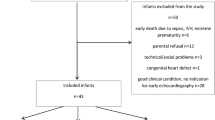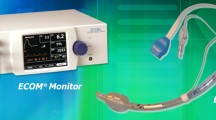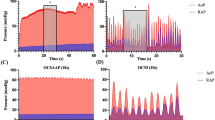Abstract
Abnormalities in coronary artery (CA) flow detected by echocardiography are increasingly used to guide clinical decisions in patient management. Increased CA flow has been seen postoperatively in congenital cardiac surgery. This study sought to determine immediate postoperative changes in left anterior descending (LAD) CA flow velocities, and to investigate possible factors associated with these changes. CA flow in the proximal LAD was sampled with pulsed-wave Doppler during trans-esophageal echocardiography imaging in the immediate preoperative and postoperative studies in 46 subjects. The peak velocity, velocity time integral (VTI), VTI corrected for heart rate (VTIc), and VTI rate pressure product (VTIrpp) were determined. The percent change in each measure between the preoperative and postoperative study was calculated and compared to age, body surface area (BSA), cardiopulmonary bypass time, cross-clamp time, and number of cardioplegia (CP) doses. The pH, oxygen saturation, temperature, and hemoglobin concentration (Hb) were compared for those with and without increased flow characteristics. There was an overall increase in LAD flow parameters in subjects who underwent congenital cardiac surgery. There was a significant and positive correlation of percent change in VTI, VTIc, and VTIrrp with number of CP doses and lower Hb. We propose that this phenomenon is likely of multifactorial origin, involving autoregulatory mechanism disturbance. The imaging and measurement of LAD flow velocities are feasible, reliable, and is positively correlated with number of CP doses. Interpretation of postoperative LAD flow velocities should be made in the context of intraoperative events since heart rate, blood pressure, and Hb concentration also influence CA flow parameters.


Similar content being viewed by others
References
Aburawi EH, Berg A, Liuba P, Pesonen E (2007) Effects of cardiopulmonary bypass surgery on coronary flow in children assessed with transthoracic Doppler echocardiography. Am J Physiol Heart Circ Physiol 293:H1138–H1143
Aburawi EH, Carlsson M, Berg A (2008) Coronary artery stenosis in asymptomatic child after arterial switch operation: detection by transthoracic colour-flow Doppler echocardiography. Acta Paediatr 97:376–378
Aburawi EH, Berg A, Pesonen E (2009) Coronary flow before and after surgical versus device closure of atrial septal defect. Int J Cardiol 135:14–20
Assaqqat MA, Hassan W, Siblini G (2003) Coronary arterial compression treated by stenting after replacement of the mitral valve in a child. Cardiol Young 13:475–478
Donnelly JP, Raffel DM, Shulkin BL, Corbett JR, Bove EL, Mosca RS et al (1998) Resting coronary flow and coronary flow reserve in human infants after repair or palliation of congenital heart defects as measured by positron emission tomography. J Thorac Cardiovasc Surg 115:103–110
El-Segaier M, Lundin A, Hochbergs P, Jogi P, Pesonen E (2010) Late coronary complications after arterial switch operation and their treatment. Catheter Cardiovasc Intervent 76:1027–1032
Ender J, Selbach M, Borger MA, Krohmer E, Falk V, Kaisers UX et al (2010) Echocardiographic identification of iatrogenic injury of the circumflex artery during minimally invasive mitral valve repair. Ann Thorac Surg 89:1866–1872
Fayad G, Modine T, Le Tourneau T, Decoene C, Azzaoui R, Al-Ruzzeh S et al (2003) Circumflex artery stenosis induced by intraoperative radiofrequency ablation. Ann Thorac Surg 76:1291–1293
Gohra H, Tsuboi H, Sasaki G, Minami Y, Hamano K, Katoh T et al (1996) Effect of cardioplegic arrest and reperfusion on coronary reserve and autoregulation. Ann Thorac Surg 62:744–749
Gohra H, Fujimura Y, Hamano K, Noda H, Katoh T, Zempo N et al (1999) Nitric oxide release from coronary vasculature before, during, and following cardioplegic arrest. World J Surg 23:1249–1253
Greenway SC, Bradley TJ, Caldarone CA, Silverman NH, Hanley FL, Smallhorn JF (2006) Aortopulmonary window with anomalous origin of the right coronary artery from the pulmonary artery: two cases highlighting the importance of complete pre-operative echocardiographic evaluation of the coronary arteries in all conotruncal anomalies. Eur J Echocardiogr 7:379–382
Hallstrom S, Gasser H, Neumayer C, Fugl A, Nanobashvili J, Jakubowski A et al (2002) S-nitroso human serum albumin treatment reduces ischemia/reperfusion injury in skeletal muscle via nitric oxide release. Circulation 105:3032–3038
Harada K, Orino T, Hironaka C, Takahashi Y, Takada G (1999) Coronary blood flow velocity in normal infants and young adults assessed by transthoracic echocardiography. Am J Cardiol 83(1583–5):A8
Huk I, Nanobashvili J, Neumayer C, Punz A, Mueller M, Afkhampour K et al (1997) L-arginine treatment alters the kinetics of nitric oxide and superoxide release and reduces ischemia/reperfusion injury in skeletal muscle. Circulation 96:667–675
Jin XY, Gibson DG, Pepper JR (1999) The effects of cardioplegia on coronary pressure-flow velocity relationships during aortic valve replacement. Eur J Cardiothorac Surg 16:324–330
Lytrivi ID, Wong AH, Ko HH, Chandra S, Nielsen JC, Srivastava S et al (2008) Echocardiographic diagnosis of clinically silent congenital coronary artery anomalies. Int J Cardiol 126:386–393
Mulpur AK, Kotidis KN, Nair UR (2000) Partial circumflex artery injury during mitral valve replacement: late presentation. J Cardiovasc Surg (Torino) 41:333–334
Munzel T, Daiber A, Ullrich V, Mulsch A (2005) Vascular consequences of endothelial nitric oxide synthase uncoupling for the activity and expression of the soluble guanylyl cyclase and the cGMP-dependent protein kinase. Arterioscler Thromb Vasc Biol 25:1551–1557
Paul T, Kakavand B, Blaufox AD, Saul JP (2003) Complete occlusion of the left circumflex coronary artery after radiofrequency catheter ablation in an infant. J Cardiovasc Electrophysiol 14:1004–1006
Sangha R, Hui P (2004) Intravascular ultrasound imaging and percutaneous intervention in a patient with post-mitral valve replacement circumflex coronary artery occlusion. J Invasive Cardiol 16:351–352
Sathanandam S, Cui W, Nguyen NV, Husayni TS, Van Bergen AH, Sajan I et al (2010) Ventriculocoronary artery connections with the hypoplastic left heart: a 4-year prospective study: incidence, echocardiographic and clinical features. Pediatr Cardiol 31:1176–1185
Sellke FW, Boyle EM Jr, Verrier ED (1996) Endothelial cell injury in cardiovascular surgery: the pathophysiology of vasomotor dysfunction. Ann Thorac Surg 62:1222–1228
Soylu O, Celik S, Karakus G, Yildirim A, Ergelen M, Zencirci E et al (2008) Transthoracic Doppler echocardiographic coronary flow imaging in identification of left anterior descending coronary artery stenosis in patients with left bundle branch block. Echocardiography 25:1065–1070
Toyota S, Amaki Y (2000) Measurement of coronary sinus flow using transesophageal echocardiography in patients undergoing coronary artery bypass grafting. J Clin Anesth 12:270–272
Wong D, Golding F, Hess L, Caldarone CA, Van Arsdell G, Manlhiot C et al (2008) Intraoperative coronary artery pulse Doppler patterns in patients with complete transposition of the great arteries undergoing the arterial switch operation. Am Heart J 156:466–472
Author information
Authors and Affiliations
Corresponding author
Ethics declarations
Conflict of interest
This study was performed retrospectively with approval from the Stanford IRB. No funding was received. There are no conflicts of interest.
Rights and permissions
About this article
Cite this article
Davidson, H., Punn, R. & Tacy, T.A. Cardioplegia Dose Effect on Immediate Postoperative Alterations in Coronary Artery Flow Velocities After Congenital Cardiac Surgery. Pediatr Cardiol 37, 364–371 (2016). https://doi.org/10.1007/s00246-015-1285-3
Received:
Accepted:
Published:
Issue Date:
DOI: https://doi.org/10.1007/s00246-015-1285-3




